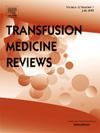FARES-II (LEX-211) 3期多中心随机临床试验:四因子凝血酶原复合物浓缩物优于冷冻血浆治疗心脏手术中凝血性出血
IF 2.5
2区 医学
Q2 HEMATOLOGY
引用次数: 0
摘要
心脏手术合并体外循环(CPB)常并发凝血性出血,导致发病率和死亡率。尽管指南建议使用冷冻血浆(FP)或四因子凝血酶原复合物(PCC)进行出血管理,但北美的主要治疗方法是FP。这项随机对照非劣效性试验比较了PCC与FP在心脏手术中的疗效和安全性。设计与方法fares - ii (LEX-211;NCT05523297)纳入年龄≥18岁接受CPB心脏手术的患者。鱼精蛋白给药后,INR≥1.5发生凝血性出血的患者按1:1随机分组接受PCC治疗(≤60 kg为1500 IU;2000 IU(≤60 kg)或FP(≤60 kg)4u(60公斤)。临床小组在治疗开始前对分组分配不知情。主要终点是止血反应(如果在治疗开始后60分钟至24小时内没有额外的止血干预,则有效)。安全性终点包括30天治疗后出现的严重不良事件、血栓栓塞事件和死亡。结果在12个站点的538例入组患者中,420例被随机、治疗、同意并纳入分析(PCC=213;FP = 207)。各组间基线特征具有可比性;中位(范围)年龄为66岁(20-88岁),74%的患者为男性。PCC患者有效止血率为77.9% (n=166), FP患者有效止血率为60.4% (n=125)(差异17.6%;95% ci 8.7, 26.4;术中;0.0001表示非劣效性和优越性)。总体而言,cpb后24小时内输注同种异体血液制品单位(包括干预FP)的平均(95% CI)数量在PCC患者中为6.6(5.9,7.5),在FP患者中为13.8(12.3,15.5)(比值0.48;95% ci 0.41, 0.57;术中;0.0001)。治疗后出现的血栓栓塞事件和死亡率在PCC患者中分别为8.5% (n=18)和3.3% (n=7),在FP患者中分别为7.2% (n=15)和3.9% (n=8)。治疗后出现的严重不良事件(36.2% vs 47.3%;相对危险度0.76;95% ci 0.61, 0.96;P =0.02)和急性肾损伤(10.3% vs. 18.8%;相对危险度0.55;95% ci 0.34, 0.89;p=0.02)与FP组相比,PCC组的发生率明显降低。结论pcc在心脏手术出血患者中具有较好的止血效果,且在安全性上优于FP。这些发现支持在心脏外科出血管理中使用PCC而不是FP。本文章由计算机程序翻译,如有差异,请以英文原文为准。
Four-Factor Prothrombin Complex Concentrate is Superior to Frozen Plasma for Coagulopathic Bleeding in Cardiac Surgery—The FARES-II (LEX-211) Phase 3, Multicentre, Randomized, Clinical Trial
Introduction
Cardiac surgery with cardiopulmonary bypass (CPB) is often complicated by coagulopathic bleeding, leading to morbidity and mortality. Although guidelines recommend using either frozen plasma (FP) or four-factor prothrombin complex (PCC) for bleeding management, the mainstay of therapy in North America is FP. This randomized controlled non-inferiority trial compared the efficacy and safety of PCC with FP in cardiac surgery.
Design and Methods
FARES-II (LEX-211; NCT05523297) included patients aged ≥18 years undergoing cardiac surgery with CPB. After protamine administration, patients who developed coagulopathic bleeding with INR ≥1.5 were randomized 1:1 to receive PCC (1500 IU if ≤60 kg; 2000 IU if >60 kg) or FP (3 U if ≤60 kg; 4 U if >60 kg). The clinical team was blinded to group allocation until treatment initiation. The primary endpoint was hemostatic response (effective if no additional hemostatic interventions were administered from 60 min to 24 h after treatment initiation). Safety endpoints included 30-day treatment-emergent serious adverse events, thromboembolic events and death.
Results
Of 538 enrolled patients at 12 sites, 420 were randomized, treated, consented and included in the analysis (PCC=213; FP=207). Baseline characteristics were comparable between groups; median (range) age was 66 years (20–88) and 74% of patients were male. Effective hemostasis was achieved in 77.9% (n=166) of PCC patients vs. 60.4% (n=125) of FP patients (difference 17.6%; 95% CI 8.7, 26.4; p< 0.0001 for non-inferiority and superiority). Overall, the mean (95% CI) number of allogeneic blood product units transfused within 24 h post-CPB, including intervention FP, was 6.6 (5.9, 7.5) in PCC patients and 13.8 (12.3, 15.5) in FP patients (ratio 0.48; 95% CI 0.41, 0.57; p< 0.0001). Treatment-emergent thromboembolic events and mortality occurred in 8.5% (n=18) and 3.3% (n=7) of PCC patients and 7.2% (n=15) and 3.9% (n=8) of FP patients, respectively. Treatment-emergent serious adverse events (36.2% vs. 47.3%; relative risk 0.76; 95% CI 0.61, 0.96; p=0.02) and acute kidney injury (10.3% vs. 18.8%; relative risk 0.55; 95% CI 0.34, 0.89; p=0.02) were significantly less frequent in the PCC group compared with the FP group.
Conclusion
PCC has superior hemostatic efficacy and may have safety advantages over FP in patients requiring coagulation factor replacement for bleeding during cardiac surgery. These findings support the use of PCC over FP for bleeding management in cardiac surgery.
求助全文
通过发布文献求助,成功后即可免费获取论文全文。
去求助
来源期刊

Transfusion Medicine Reviews
医学-血液学
CiteScore
11.60
自引率
0.00%
发文量
40
审稿时长
21 days
期刊介绍:
Transfusion Medicine Reviews provides an international forum in English for the publication of scholarly work devoted to the various sub-disciplines that comprise Transfusion Medicine including hemostasis and thrombosis and cellular therapies. The scope of the journal encompasses basic science, practical aspects, laboratory developments, clinical indications, and adverse effects.
 求助内容:
求助内容: 应助结果提醒方式:
应助结果提醒方式:


